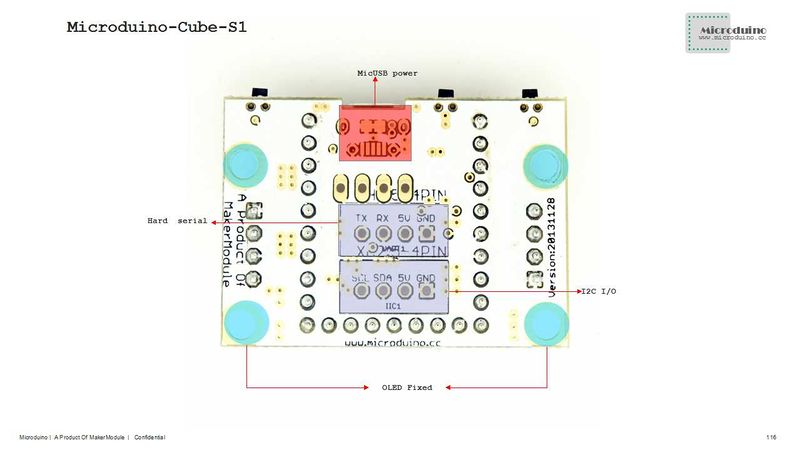Difference between revisions of "Microduino-Shield Cube-S1"
From Microduino Wiki
(→Application) |
|||
| (5 intermediate revisions by 2 users not shown) | |||
| Line 6: | Line 6: | ||
==Features== | ==Features== | ||
*Compatible with the pin of Arduino Uno; | *Compatible with the pin of Arduino Uno; | ||
| − | * | + | *Uniform Microduino interface standard and rich peripheral modules, capable of having a fast and flexible connection and extension with other modules and sensors meeting Microduino interface standard; |
*Onboard analog button and sensor interface; | *Onboard analog button and sensor interface; | ||
==Specification== | ==Specification== | ||
*Electrical specification | *Electrical specification | ||
| − | **MicroUSB power | + | **MicroUSB power supply; |
| − | **3.3V constant | + | **3.3V constant voltage; |
| − | **Select the 5V or 3.3V power via PWR jumper(The default voltage is 3.3V) | + | **Select the 5V or 3.3V power via PWR jumper(The default voltage is 3.3V); |
| − | **Onboard power supply indicator(5V and PWR) | + | **Onboard power supply indicator(5V and PWR). |
*Extension | *Extension | ||
| − | **Onboard reset | + | **Onboard reset button; |
| − | **The fixed OLED | + | **The fixed OLED base; |
| − | **Two serial ports including (RX0,TX0)and (D2,D3) | + | **Two serial ports including (RX0, TX0)and (D2, D3); |
| − | **Two IIC | + | **Two IIC interfaces; |
| − | ***Two analog button interfaces connected to | + | ***Two analog button interfaces connected to A7; |
| − | **The sensor interface can be selected and combined through | + | **The sensor interface can be selected and combined through jumpers: |
***PWR, A3, GND, PWR or PWR, A3, GND, GND or PWR, D6, GND, PWR or PWR, D6, GND,GND (Users can make the connection as they like). | ***PWR, A3, GND, PWR or PWR, A3, GND, GND or PWR, D6, GND, PWR or PWR, D6, GND,GND (Users can make the connection as they like). | ||
| Line 32: | Line 32: | ||
Eagle PCB: '''[[File:Microduino-Cube-S1.zip]]''' | Eagle PCB: '''[[File:Microduino-Cube-S1.zip]]''' | ||
| − | Main | + | Main Component: |
| − | *3.3V Voltage | + | *3.3V Voltage Stabilizing chip LP2985: '''[[File:LP2985.pdf]]''' |
==Development== | ==Development== | ||
| Line 44: | Line 44: | ||
*You can download Microduino test program, which together with OLED to test the function of Microduino-Cube-S1's two analog buttons. Just as follows: | *You can download Microduino test program, which together with OLED to test the function of Microduino-Cube-S1's two analog buttons. Just as follows: | ||
https://github.com/Microduino/Microduino_Tutorials/commit/b0e0fe74269ee0f6a886d8fa8db497ec57cc4073 | https://github.com/Microduino/Microduino_Tutorials/commit/b0e0fe74269ee0f6a886d8fa8db497ec57cc4073 | ||
| − | *Hardware Needed:Microduino FT232R, Microduino Core, Microduino-Cube-S1 and Microduino | + | *Hardware Needed:Microduino FT232R, Microduino Core, Microduino-Cube-S1 and Microduino OLED; |
| − | *Software Needed:Microduino example program (Arduino part) and Arduino IDE(Version 1.0 and higher) | + | *Software Needed:Microduino example program (Arduino part) and Arduino IDE(Version 1.0 and higher); |
*Open the example program in IDE, select the board "Microduino Core (Atmega328P@16M,5V)", then download directly; | *Open the example program in IDE, select the board "Microduino Core (Atmega328P@16M,5V)", then download directly; | ||
*After the download, "No button is pressed " is displayed on the OLED, | *After the download, "No button is pressed " is displayed on the OLED, | ||
| − | **Press the left button and "Press the left button" will come out, meaning the left button gets | + | **Press the left button and "Press the left button" will come out, meaning the left button gets pressed; |
| − | **Press the right button and "Press the right button" will be displayed on the OLED, meaning the right button is | + | **Press the right button and "Press the right button" will be displayed on the OLED, meaning the right button is pressed; |
**When no button is pressed, "No button is pressed " will be displayed, which is just like the initial state. | **When no button is pressed, "No button is pressed " will be displayed, which is just like the initial state. | ||
Latest revision as of 06:24, 4 August 2017
| Language: | English • 中文 |
|---|
ContentsFeatures
Specification
DocumentEagle PCB: File:Microduino-Cube-S1.zip Main Component:
DevelopmentMicroduino-Cube-S1 is capable of having a fast and flexible connection and extension with other modules and sensors meeting Microduino interface standard, achieving specific function. Application
https://github.com/Microduino/Microduino_Tutorials/commit/b0e0fe74269ee0f6a886d8fa8db497ec57cc4073
BugHistoryPictureFrontBackVideo |






